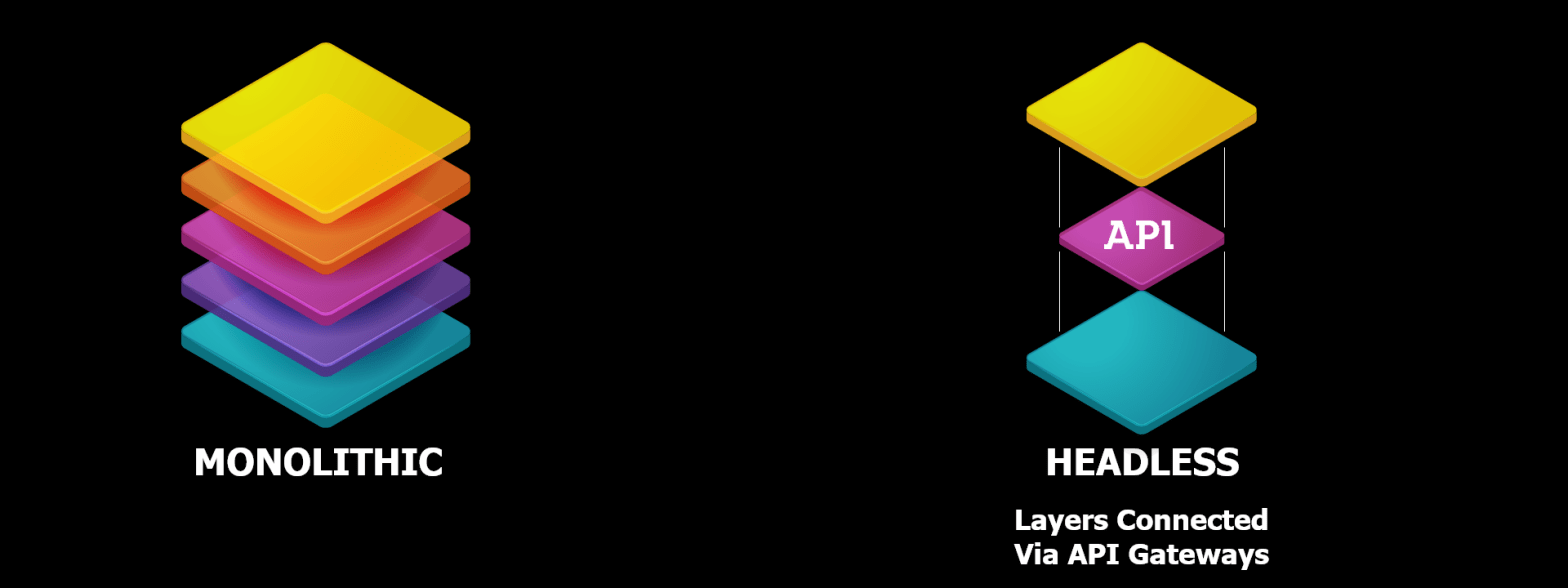
Headless Commerce: Modern Paradigm for eCommerce
![]() Taru M.
Taru M.
Published: 17 Aug, 2022
Headless commerce is a solution that emerged to solve User Experience issues in the eCommerce paradigm. Customer satisfaction and convenience are the most vital aspects besides pricing and quality that online businesses need to do right to derive growth and earn substantial profit margins. But they were finding it painstakingly difficult with monolithic systems to deliver experiences that would initiate customer loyalty.
In addition to that, customers don’t use only the web to shop online. More than ever, they are spending considerable time on social media. With the rise in online shopping during and after the pandemic, it appeared physical stores are now obsolete. But this deduction proved to be incorrect. On the contrary, researchers found businesses need to offer personalization – not to the level of creepiness – by incorporating an omnichannel strategy.
Also, the rigidness and pre-built solutions inherent in monolithic systems fall short in the volatile and complex world we are living in. Businesses need to spend hefty resources – in terms of both time and money – to upgrade these systems. This blog will clarify headless architecture, its implementation in the eCommerce industry, how it differs from microservices, and the challenges.
We hope this blog will clear many of your doubts. But if you have specific queries, you can contact our eCommerce development company and get a free consultation from our experienced software project managers.
Table of contents
1. Architecture Underneath Headless Commerce
2. Is Headless Commerce The Same As Microservices?
3. Headless Approach For eCommerce: Headless Commerce
4. Benefits Of Headless Commerce
Architecture Underneath Headless Commerce
Headless is a philosophy of constructing an application architecture in which the backend and frontend are loosely coupled. It allows flexibility and less dependency between Presentation and Logic layer. APIs are an integral component of headless architecture as communication among layers happens through them. GraphQL and REST APIs bring to life any variation of headless architecture.
Accordingly, both layers can be developed independently without affecting each other. This solves the problem businesses face with monolithic architecture – primarily the risk of the emergence of errors with the changes in either of the layers.
Headless architecture is mostly finding its implementation in digital eCommerce and content. Interestingly, Gartner – a technology research company, releases its findings on the hyped technologies among various sectors. Its Hype Cycle in Digital Commerce, 2021, shows that API-based Digital Commerce will reach a plateau of productivity in 2-5 years.
It is the subset of a more innovative digital commerce architecture – MACH. MACH stands for Microservice, API-First, Cloud-Native, and Headless. Many popular eCommerce platforms like Shopify and Adobe Commerce now provide headless solutions. And it is undoubtedly helping in democratizing the headless approach. As implementing full-blown MACH is still expensive to build and manage by small businesses.
Is Headless Commerce The Same As Microservices?
Headless undoubtedly has the same architecture principle of microservice – i.e., decoupling layers and enhancing independence and modularity. The difference lies in the scope. Where Headless is only creating loose boundaries between the presentation layer and backend, microservice architecture divides the complete application into small, independent services. Again, these services talk with each other using APIs.
For example – in an eCommerce application, implementing microservices architecture means designing a single service for checkout and another independent service for discounts. In an app like Uber, there can be different services for driver management, trip management, billing, etc. In huge tech companies, each service is developed and maintained by independent teams facilitating effective scalability.
Why is Microservices Architecture Preferred For Complex Applications?
- Easy to test, maintain and reuse code compared to monolithic architecture.
- Every service can be modified independently without making changes in the whole app. As a result, developers will work on specific services without coming into contact with other ones. It improves agility and reduces updation costs.
- Since components in microservices architecture are connected via APIs gateways, errors in one of the hundreds of services won’t halt the functioning of the application. So, software gets more resilient.
- Integrates well with the existing monolithic architecture. Consequently, businesses can modernize their legacy systems by incrementally adopting a microservices software design philosophy.
Nevertheless, developing and maintaining microservices architecture is not simple. It requires DevOps and special monitoring tools to keep the application resilient.
Headless Approach For eCommerce: Headless Commerce
eCommerce is flourishing with headless architecture as businesses can deliver an exceptional user experience. UX is not just concerned with attractive visuals; monolithic eCommerce platforms even fall short of giving designers resources to build enriching custom visuals. So, deducing that you cannot level up your site’s UX with traditional coupled architecture is simple. That is why enterprises and mid-level enterprises have adopted headless commerce to refine customer satisfaction.
Companies like Commercetools offer complete MACH architecture. Not only that, the Headless Commerce term was coined by Dirk Hoerig, co-founder of Commertools. Getting cognizant of the shift to Headless and APIs, monolithic eCommerce platforms – Magento and Shopify, to name a few- also provides businesses the flexibility to decouple storefront from the platform’s backend services.
Complement with: Top 8 Headless eCommerce Platforms & Selection Criterion.
Benefits Of Headless Commerce
Let’s see why eCommerce businesses are shifting to headless commerce.
Reach To Customers Where They are – Omnichannel Strategy
Research evidently shows the need to integrate various points of sale – be they digital or brick-and-mortar. Even though businesses are hearing more and more about omnichannel strategy. They still are not able to fully embrace it. Being stuck on monolithic architecture, implementing omnichannel is too burdensome.
A few years back, omnichannel was just considered an add-on, but post-covid after the behavioral shift, it is imperative for survival. Most GenZ consumers expect a seamless experience across the brand’s physical stores, mobile app, eCommerce website, social media, email, etc. Even though putting it into practice demands careful strategy, confusion or unpreparedness often creates more negatives than positives. Without the underlying architecture that will make it easy for developers, putting it into action is downright impossible
Composable commerce – another term for headless commerce allows developers to quickly craft User Interfaces for different sales channels – websites, smart watches, digital banners for physical stores, etc. It is simply because teams can independently work on the front-end and fetch content from a unitary headless CMS ( Content Management System).
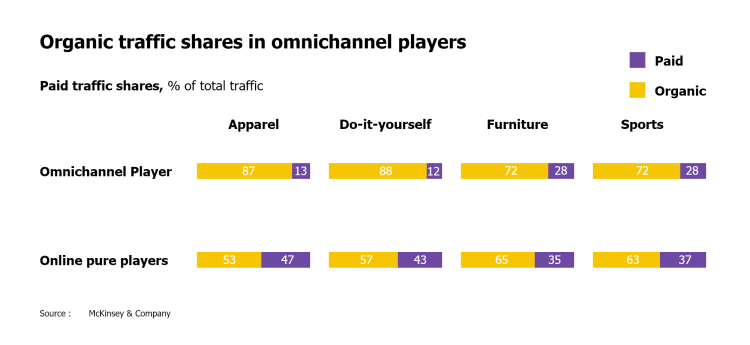
Which business doesn’t work or wishes to reduce their marketing cost and still experience growth in sales? Studies done by leading research institutes show that stores that embrace omnichannel fully have to spend less in paid traffic than stores with no physical presence to support their online channels. Stores with both online and offline stores tend to see more surge in organic traffic.
Personalized User Interface and Branding Aligned With Values
Personalization has impacted users to such an extent that if today’s companies don’t provide it, they feel the business is not doing enough to meet their needs. Customers just don’t want recommendations, they demand those be accurate and meaningful. In addition, young consumers don’t mind getting to know them until that information is used to help them keep track of inventory of essential items and notify them at the right time.
Research from prominent companies – Infosys, Accenture, Mckinsey & Company – concludes personalization is hugely critical for the success of any online business.
A below-par impersonal experience frustrates almost 71% of consumers. – Study by Segment
91% of consumers shop more with brands that provide relevant recommendations to them. – Accenture
GenZ prefers brands that align with its values. Even though they are the most technically savvy and spend considerable time on social media. They still are aware of climate change, gender, and racial discrimination. Visual design is one of the ways that brands can communicate these values. The problem with monolithic stores is inflexibility when customizing visuals and front-end. Even the best platforms offer few themes and templates. Consequently, every store just looks quite similar.
With headless commerce, the front-end is fully customizable, and businesses are free to integrate backend services with their preferred web frameworks.
For example, Four Pillar Gin is an Australian gin distillery whose founders are passionate about making gin with local ingredients, hospitality, and fun. Using BigCommerce for the backend and WordPress for the frontend, they were able to create a unique and fresh look for their eCommerce websites as well as apply omnichannel marketing by integrating their two physical stores with the digital site. Expressing their craft is significant in how they want to run the business. They do so by adding recipes, stories, botanicals, and distilling processes. This requires building a content-rich eCommerce website that is agile and flexible so that marketing and designing teams can experiment with their ideas – Possible only with headless architecture.
Want to read more inspiring examples of headless commerce? Read 5 World-Class Headless Commerce Examples.
Reduce Time-To-Market
Shipping your products a little late into the market leads to drastic monetary and market share losses. On the other hand, reducing time-to-market needs structural changes in the product development lifecycle. Technology is one vital factor besides management, design, and coordination among inter-related teams that helps faster product development.
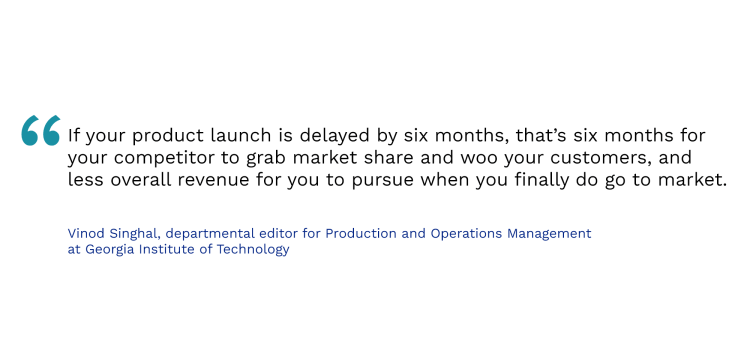
How is a monolithic architecture obstacle here? It doesn’t allow the team to be agile and independent. Because of this, designers and marketers cannot swiftly iterate the concepts. Headless architecture, therefore, not only modernizes your technology stack. Its effects are amplified in the way the team works.
Businesses reap maximum benefits from a proper architecture that allows for faster development in extreme rare events. Covid-19 was one such unpredictable event that toppled global businesses. Overnight, teams had to restructure, innovate, and update content and product catalogs to respond to the changing world.
Some of the major benefits when businesses market the products swiftly:
- Substantial profit margins
- More market share
- The lifespan of products increases as you launch them way sooner than your competitors
- A sizeable reduction in development costs
Consistent Integrations – Best-Of-Breed Solutions
We often like one particular feature – say inventory management of a platform- but find some other service – for example, payment gateways not up to the notch. But when you are locked in with a monolithic eCommerce platform, you have to settle for its good and bad.
Headless architecture solves this problem too. Businesses can integrate solutions of their choice for different services like payments, booking, email marketing, etc. It further improves agility, resiliency, and ROI.
Challenges With Headless Architecture
Adopting and implementing any technology has its own set of challenges. So when you hear that headless commerce requires a shift in mindset – it shouldn’t come as a surprise. Eventually, you have to analyze the benefits you will be getting after carefully measuring costs.
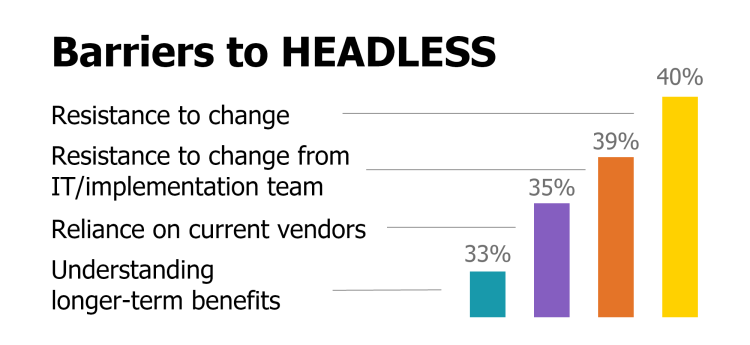
Dedicated and Skilled Team To Manage Composable Services
Since the application is now a bundle of services, you need DevOps and a team with a niche skill set to squeeze out all the benefits from headless architecture efficiently. Isolation is a recipe for disaster, but coordination among cross-functional teams is continuous hard work.
The Total Cost Of Ownership
Measuring cost is not straightforward as in monolithic architecture. With the latter, you know what you are paying for the out-of-box solutions. While this definitely reduces complexity in terms of pricing, you will see significantly low ROI when you calculate it over the years. It is because monolithic reduces the development cycle, forces vendor lock-in, and customizing and upgrading your online store becomes both expensive and time intensive.
To measure ROI in headless architecture, you need to incorporate cost, speed, and time. As we mentioned above in the benefits section, your businesses achieve high growth because of agility in working culture, flexibility in the technology stack, and timely response to the changing business environment.
Nevertheless, you will find yourself spending on the following when you move to headless solutions:
- Vendors or eCommerce platforms
- Outsourcing development
- Whether you build frontend from scratch or buy Frontend-as-a-service
- APIs for integrating best-of-breed solutions
- Maintenance
The Trend Shows Headless Commerce Is The Future
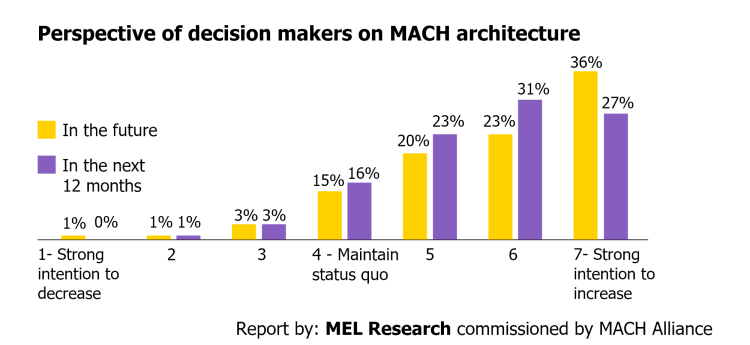
Mel Research conducted an Enterprise MACHified study that included high-level decision makers such as CIOs, CTOs, VP, and senior managers. Almost all of them were ready to shift to headless and microservice architecture in the next 12 months. They want to work more on enriching Customer Experience (CX) and believe MACH adoption is the way ahead.
Copyright © 2023 NetMaxims Technologies Pvt. Ltd.
All Rights Reserved














